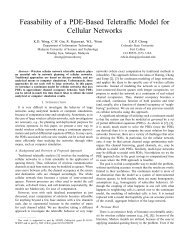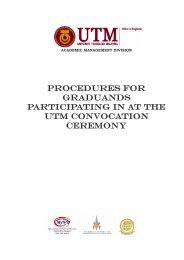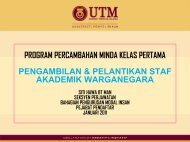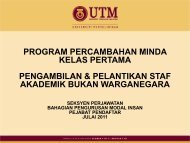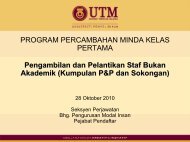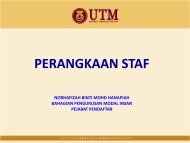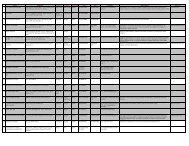PAN ASIA ICT R&D Grants Programme - UTM
PAN ASIA ICT R&D Grants Programme - UTM
PAN ASIA ICT R&D Grants Programme - UTM
- TAGS
- grants
- programme
- web.utm.my
Create successful ePaper yourself
Turn your PDF publications into a flip-book with our unique Google optimized e-Paper software.
services at the wireless relay stations<br />
provided there is an adequate Internet<br />
connection. This allows the project to<br />
scale: one can envision the wireless<br />
relay stations offering Internet browsing<br />
functions.<br />
Project Method<br />
The first Wireless Internet Post Office<br />
(WIPO) component is the Internet<br />
Gateway station or Base Station. This<br />
station is a PC Server and e-mail relay<br />
connected to the Internet and is the<br />
gateway between the Internet and the<br />
roaming PDAs. Since text messages do<br />
not consume much bandwidth or<br />
storage, a single PC can serve thousands<br />
of PDAs.<br />
While setting up these stations, the<br />
project team investigated various<br />
forms of information: from how to<br />
setup and maintain e-mail accounts and<br />
services to cost and kinds of Internet<br />
access in the Asia-Pacific region.<br />
The second WIPO component is the<br />
Wireless Networking Architecture.<br />
The architecture uses a multi-point-tomultipoint<br />
mesh to network the<br />
wireless relay stations. The Internet<br />
Wireless network architecture being<br />
tested<br />
Wireless Internet Post Office<br />
One of the Internet Gateway stations<br />
uses this robust architecture so a<br />
message is delivered even if parts of<br />
the network nodes are down or out of<br />
range of the PC server. Since asynchronous<br />
text messages are tolerant of large<br />
lag times, many wireless relay stations<br />
may be used, spanning large distances<br />
between PDA synchronization stations<br />
and the base station Internet connection.<br />
Network reliability is important to<br />
insure the message gets though. The<br />
project team found that providing<br />
several redundant paths greatly<br />
increases the reliability of the communication<br />
system. The project team also<br />
investigated: wireless network<br />
protocols - including packet size, error<br />
correction and detection; topology<br />
performance, scalability, “hiddennode”<br />
problems, robustness; communication<br />
security; tradeoff of radios to get<br />
better performance; and power<br />
management.<br />
The third WIPO component is the<br />
Wireless Relay Station. These stations<br />
bring text messaging out to the remote<br />
villages and synchronize local PDAs.<br />
These stations can be backed up with<br />
batteries, so they can be placed<br />
anywhere using line-of-sight directional<br />
antennas for long range. Any<br />
number of these relay stations can be<br />
placed in a series to cover vast distances.<br />
While setting up the relay stations,<br />
the project team researched: radio<br />
operation, station installation and<br />
software monitoring; antenna performance,<br />
tolerance to realignment and<br />
tower interference; PDA synchronization<br />
software; hardware design and<br />
requirements (processor speed, DRAM<br />
and FLASH memory); mechanical<br />
(weatherproofing, ergonomics of<br />
installation and maintenance); remote<br />
firmware update mechanism; security;<br />
and the links from PDAs to wireless<br />
relay stations (cable, optical, RF).<br />
The last WIPO component is the<br />
Wireless Station Power Plant. This<br />
power plant provides all the power for<br />
the wireless relay station, making it<br />
self-sufficient for remote locations (e.g.<br />
mounted on a mountain ridge to bring<br />
connectivity to a village located in a<br />
valley).<br />
Lasting Impacts<br />
The project team solved the multitude<br />
of technical and system design issues<br />
inherent in a Wireless Internet Post<br />
Office (WIPO), and made it provide<br />
digital access to the widest possible<br />
population at the lowest usage and<br />
capital cost. The design provides a<br />
viable and effective means of bridging<br />
the digital divide and bring low cost<br />
10



